Tomato Disease Management
Begomovirus of Tomato
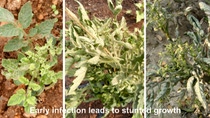
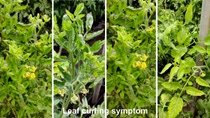
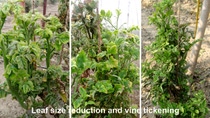
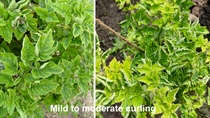
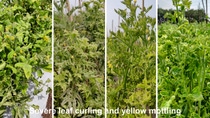
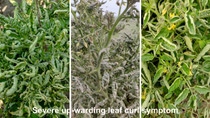
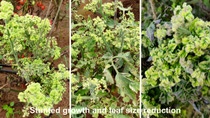

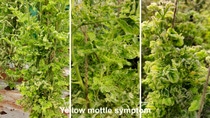
Begomovirus of Tomato
Disease and Pathogen
Tomato leaf curl disease caused by different species of begomoviruses genus infecting tomato in alone and or together in India. Tomato leaf curl disease is mainly spread by a tiny insect whitefly (Bemisia tabaci) and is one of the most important pathogens against tomato crops in India for last several years.
Identification
Begomovirus symptoms in tomato is dependent on the resistant/susceptible nature of cultivar, environment (day/night temperatures) growing conditions, potential mixed infections with other plant viruses, and even the presence of satellite molecules associated with different begomovirus species.
Tomato plants infected at an early stage (before the flowering) are severe stunting with one or more symptoms, including: a “stunted appearance” caused by short internode length, smaller than usual leaflets, yellowing and curling of leaves, and no further growth.
In adult plants, the predominant symptoms are upward cupping/curling of leaves, chlorosis on leaves, yellow mottling, and reduced leaf size. Leaves are often bent downward and may be thicker than normal leaves.
The effect on yield depends on the age of the plant when infected. If infected early, plants lose vigour and stop producing marketable fruits. When infections occur at a later stage of development, additional fruits fail to set, but fruits already present mature in a nearly normal manner.
Transmission
Tomato yellow leaf curl disease is not transmitted in seed, soil or from plant to plant by handling. It is harbored in infected host plants, some of which may be hosts that do not show symptoms. The virus causing tomato yellow leaf curl disease is spread from plant to plant by sap-sucking insect which around 0.8mm in length and have a snow-white color in adult stage called silverleaf whitefly (SLW) (the biotype B of Bemisia tabaci). The dispersal of leaf curl virus is associated with the movement of the whitefly vector. Whiteflies seldom move locally from one to plant to another, and long-distance dispersal may be facilitated by winds and human activities. It is possible that whitefly populations move from one crop to another, particularly when a crop is harvested or abandoned.
Favorable Environmental Conditions for Disease
Leaf curl disease can be observed in tomato crops throughout the affected regions. The virus is transmitted to solanaceous plants after vector feeding on infected plants or alternative hosts. The principal habitat for leaf curl virus is cultivated crops and the different weeds near around tomato fields. Epidemics and outbreaks of leaf curl disease are associated with tomato producing regions where environmental conditions are suitable for white flies, such as open fields with moderate to hot temperate. Disease incidence can vary between seasons and appears to be directly correlated with the pressure of the whitefly population.
Management
The first line of defense against any disease is producing healthy plants and growing them in an environment that is as free of the virus and its vector (whitefly) as possible. Viruses cannot be cured-only prevented.
Specific cultural measured to control the leaf curl viruses.
Before planting:
- Use leaf curl virus resistant varieties
- Select ideal planting dates in order to avoid periods of high whitefly populations
- Use whitefly infestation free seedlings, sourced from a reputable supplier
- Reflective mulch can delay or reduce the extent to which young plants become infested by whiteflies and other sucking pests.
- If possible, spray or drench with insecticides before transferring the seedling trays from nursery to field.
- Whitefly that feed on many different plant species often move rapidly from one field to others. So, remove weeds from within and around crops.
- Border crops: A 1meter strip around the field following a row crops (viz corn) with green shade net reduce the whitefly and other sucking pest movement. The row crops need to sow at least 2-3 weeks earlier than tomato transplanting.
- Do not plant new crops next to the old tomato crops. This is very important if the “old” crop is infected with virus and whiteflies.
During growth:
- Monitor routinely for sucking pests. Use yellow or blue sticky traps placed about 10 cm above the crop and inspect weekly.
- Rogue any plants showing symptoms of virus to avoid the faster spreading.
- Use recommended chemical to control whiteflies
After harvest:
1. Collect and destroy crop debris by burying or burning.
Bacterial Leaf Spot of Tomato
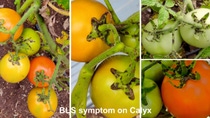
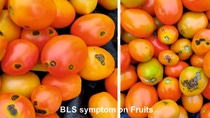
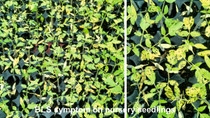

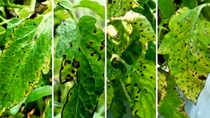
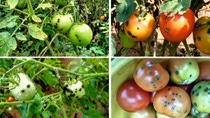
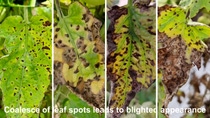



Bacterial Leaf Spot of Tomato
Disease and Pathogen
Bacterial leaf spot is caused by four species of Xanthomonas (X. euvesicatoria, X. gardneri, X. perforans, and X. vesicatoria). It causes moderate to severe damage on tomato leaf and fruit, which leads to defoliation, sports on fruits, sun-scalded fruit, and yield loss. In India, X. perforans is the predominant species associated with bacterial spot-on tomato in recent times. Due to diversity within the bacterial spot pathogens, the disease can occur at different temperatures and precipitations. An integrated approach to disease management is essential to minimizing disease risk.
Identification
Bacterial spot can affect all above ground parts of a tomato plant, including the leaves, stems, and fruit at any stage. It is difficult to reliably distinguish bacterial spot from other bacterial diseases on visual symptoms, especially in the early stages.
On tomato, leaf lesions are initially small circular, greasy water-soaked and often surrounded by a faint yellow halo. The older spots in dry dark brown to black and circular on leaves and stems. Further Spots increase in size to form large irregular dead spots and or can coalesce causing a blighted appearance of leaves. Severe infections lead to complete defoliation and plants leads to death. Fruit lesions begin as small, slightly raised blisters, which become dark brown, scab-like, and can appear slightly raised as they increase in size.
Look alike diseases: Some of the fungal and bacterial diseases occur on the foliage of tomato and can make identification difficult.
1. Septoria leaf spot produces smaller lesions with tan or light gray centers.
2. Gray leaf spot also produces smaller and lighter brown lesions than what you would see with early blight, and the center of the gray leaf spot lesions tend to crack.
3. Late blight produces lighter tan-colored lesions that typically have a light green halo. Late blight will occur all over the plant including young leaves, whereas early blight would be found primarily on the lower leaves.
4. Alternaria (early blight) produces small, brownish-black spots which can expand to about 1⁄4 - 1⁄2-inch in diameter with characteristic concentric rings in the darkened area. Lesions first develop on lower leaves and the lesions may appear in the upper leaves when the disease progress further.
Favorable Environmental Conditions for Disease
Infected plant tissue such as seeds, transplants, tomato and pepper volunteers, and crop debris are all potential sources of bacterial spot inoculum. Bacteria can move within fields by wind-driven rain, irrigation droplets, aerosols, and the handling of wet plants. Bacteria enter the plant through natural openings (stomates and hydathodes) or wounds caused by wind-driven soil, insects or mechanical damage (handling, wind whipping, high pressure sprayers). The longer the plants are wet, infection is more likely to occur. After initial infection, the disease can spread rapidly throughout an entire field.
Disease Transmission
Disease development is favored by warm, wet weather. Wind-driven rain can contribute to more severe disease as the pathogens are splashed and spread to healthy leaves and fruit. Bacterial spot pathogens can survive well in tomato debris, but they survive very poorly in soil when not associated with debris.
The bacterial pathogens can be introduced into a field on contaminated seedlings, which may or may not show symptoms.
Management:
A plant with bacterial spot cannot be cured but can prevent the infection by growing them in an environment that is as free of Xanthomonas species.
Specific cultural measure to control the bacterial diseases.
1. Start with clean equipment and tools: Clean and disinfect all tools and farm equipment prior to working with the transplants or plants. Good sanitation practices are critical to prevent contamination and cross contamination of plants by the bacterial leaf spot pathogen.
2. Crop rotation: Proper crop planning patterns like effective crop rotation system. Avoid rotations with crops in the same family as tomato (pepper, eggplant, and tobacco) for 3-4 years.
3. Healthy seedling: Use disease free seedlings, sourced from a reputable supplier who maintain high level nursery hygiene
4. Plant into a field free of volunteer tomato plants.
5. Drenching the seedling before transplanting: Apply one or two preventative copper fungicide applications and one application of streptomycin to the seedlings before transplanting them into the field.
6. Better spacing and proper staking: Stake plants to improve air circulation and reduce the contact of the plant with soil especially in moist season. Plastic mulch also provides a barrier between contaminated soil and leaves. Orient rows in the direction of prevailing winds, avoid shaded areas and avoid wind barriers.
7. Timing of irrigation: Providing only enough irrigation and avoid unnecessary supply of irrigation water. Avoid late afternoon or evening irrigation. If possible, irrigate the field early in the day to promote rapid drying of upper layer of soil.
8. Pruning: Prune leaves below the oldest fruit cluster.
9. Weeding: Control susceptible weeds such as black nightshade and hairy nightshade, and volunteer tomato plants throughout the crop.
10. Daily Scouting: Scout plants daily and destroy plants once a plant disease diagnostic laboratory has confirmed the disease.
11. Fertigation: Provide plants with adequate but not excessive nitrogen, improve the organic matter content of the soil through the use of composted green or animal waste or cover crops
12. Irrigation: Avoid overhead irrigation if possible and avoid performing crop maintenance operations while plants are wet
13. Use crop protectants: Field applications of copper fungicides, applied early and often, may slow bacterial leaf spot infection
Early Blight of Tomato
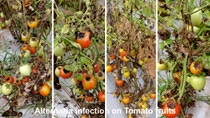

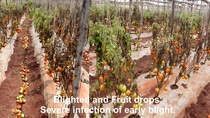
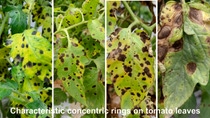
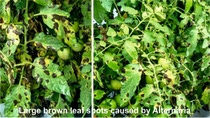
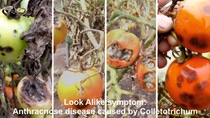
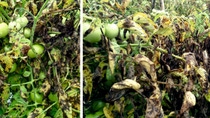

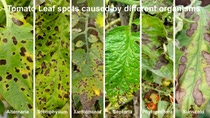
Early Blight of Tomato
Introduction
Early blight is probably the most common and widespread of foliar diseases in field-grown tomatoes across in India. Contrary to what its name suggests, this disease normally appears late in the season, as plants develop a full load of ripening fruit. As plants age and the fruit load grows, nutritional demands are higher, and tomatoes become more susceptible to early blight. Early blight invades the older, less vigorous leaves first, and moves up the plant to younger leaves. Maintaining good crop vigor throughout the season, with adequate water and nitrogen, helps plants resist early blight. Uncontrolled, early blight can completely defoliate tomato plants and cut short the harvest.
Pathogen and Lifecycle
Early blight is a fungal disease, primarily caused by the fungus Alternaria solani, although other species of Alternaria may be isolated from lesions, Alternaria solani is predominant in India. Alternaria attacks several solanaceous crops including potato, eggplant and other nightshades. Early blight disease begins when Alternaria spores (conidia) land on the leaf surface, germinate, and penetrate the leaf tissue. Fungal mycelia grow and expand, producing characteristic brown, circular lesions with dark concentric rings like a target board. These lesions produce new spores, which are spread by wind or running water, or carried by workers or implements onto new foliage. Under favorable conditions, this complete cycle – from a spore landing on a leaf to production of thousands of new spores - takes about one week. This rapid reproductive cycle explains why the disease can expand so rapidly and defoliate a crop within a matter of weeks.
Identification
Symptoms of early blight can occur on the foliage, fruit, and stem at any stage of development. The disease is more commonly observed in the field, however, seedlings in the greenhouse can be affected by collar rot (also caused by species of Alternaria).
Lesions first develop on lower leaves as small, brownish-black spots which can expand to about 1⁄4 - 1⁄2-inch in diameter with characteristic concentric rings in the darkened area. The area surrounding the lesions may become yellow and, as disease progresses, the entire leaf may turn yellow. In later stages, lesions may appear in the upper leaves and defoliation may occur in the lower part of the plant leaving the fruit susceptible to sunscald.
Fruit may become infected through the calyx around the stem attachment and are susceptible in the green or red stage. Lesions can expand to cover the entire fruit and are typically sunken, leathery, and dark brown to black with concentric rings.
So, when walking through fields, look for the circular to angular brown spots on the lower leaves, checking to see if they have the characteristic target-like rings. Look to see more elongated spots on the stems. Look for fruits which produce dense black spore masses of the fungus on the attachment regions.
Look alike diseases: Some of the fungal and bacterial diseases occur on the foliage of tomato and can make identification difficult.
Ø Septoria leaf spot produces smaller lesions with tan or light gray centers.
Ø Gray leaf spot also produces smaller and lighter brown lesions than what you would see with early blight, and the center of the gray leaf spot lesions tend to crack.
Ø Late blight produces lighter tan colored lesions that typically have a light green halo. Late blight will occur all over the plant including young leaves, whereas early blight would be found primarily on the lower leaves.
Ø Bacterial spot also may be confused with early blight when the early blight lesions are young and small or when both are present. In general, bacterial spot will be smaller (~1/16 in), may be water-soaked on the underside of the leaf, and the center of the lesion may fall out.
Disease Transmission
Spores of Alternaria solani are primarily spread by wind, air currents, and water splash. The fungus survives in plant debris in soil and, in milder climates, can survive on volunteer tomato plants.
Favorable Environmental Conditions for Disease
There are two key factors constitutes the favorable conditions: temperature and leaf-wetness. The leaf surface must be wet for spores to germinate. Growth of lesions and production of new spores are also favored by leaf moisture. So, the prolonged wetness favored the disease infection and progress. Next the temperature determines how fast these events happen. The fastest development occurs in the range between about 20°C and 30°C. Generally, the same conditions that are good for early blight also favor another key fungal and bacterial disease like Gray leaf spot, Septoria leaf spot and Bacterial leaf spot
Moreover, the Alternaria solani fungus can live more than one year in the previous crop debris. If the debris is not properly disposed then, the chances of early blight infections are more in the present crop if tomatoes are planned to grow in the same period.
Management:
1. Nunhems Resistant varieties:
There is no high resistance to early blight, however, some varieties are more tolerant to the disease: (PD inputs).
2. Common Cultural Practice
The first line of defense against any disease is producing healthy plants and growing them in an environment that is as free of the pathogen as possible. Please follow this link for the common cultural practices to prevent the inoculum and disease spread.
3. Cultural Practice specific to EB
Alternaria solani is so widespread that it is difficult to escape it completely, but several cultural practices can help. The fungus overwinters in infected crop debris and can persist from one season to the next in the same field. However, it will not survive in the soil during a rotation of 3 years or more into a non-host crop.
Crop rotation: Proper crop planning patterns like effective crop rotation system. Rotate every 2-3 years. Rotating away from tomato can reduce inoculum density in a field.
Maintain plant vigor: Maintaining adequate fertilization and improving host vigor can reduce susceptibility to early blight. Particularly, do not over-fertilize with potassium and maintain adequate levels of both nitrogen and phosphorus.
Better spacing and proper staking: Stake plants to improve air circulation and reduce the contact of the plant with soil especially in moist season. Plastic mulch also provides a barrier between contaminated soil and leaves. Orient rows in the direction of prevailing winds, avoid shaded areas and avoid wind barriers.
Timing of irrigation: Providing only enough irrigation and avoid unnecessary supply of irrigation water. Avoid late afternoon or evening irrigation. If possible, irrigate the field early in the day to promote rapid drying of upper layer of soil.
Pruning: Prune leaves below the oldest fruit cluster.
Weeding: Control susceptible weeds such as black nightshade and hairy nightshade, and volunteer tomato plants throughout the crop.
4. Chemical Control for Conventional Growers
For Current information on disease recommendations in specific crops including information on chemical control & pesticide management, please visit the following link
- The recommendations do not represent endorsement by Nunhems India Pvt Ltd
- Insecticide label registration are subject to change and changes may have occurred since this posted.
- Due to the variable regulations around use of registered pesticides, relevant authority should be consulted to determine which products are legally allowed for use when considering chemical control.
- The pesticide user is always responsible for applying products in accordance with label directions. Always read and carefully follow the instruction on the container label.
- Pesticides should always be used in a lawful manner, consistent with the product's label.
Late Blight of Tomato
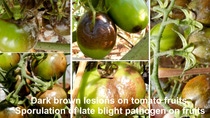
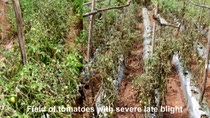



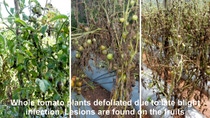
Late Blight of Tomato
Disease and Pathogen
Tomato late blight is caused by the oomycete pathogen Phytophthora infestans that affects a different Solanum vegetable including tomato and potato. It is occurring mostly in hilly areas especially when the days are cloudy, cool, wet, or overcast with heavy dews and mists.
Identification
The first symptoms of late blight on tomato leaves are irregularly shaped, water-soaked lesions, often with a lighter halo or ring around them in the succulent leaves in the canopy. As the disease progresses, lesions enlarge causing leaves to brown, shrivel and die. Late blight can also attack stem and tomato fruit in all stages of development. Symptomatic tomato fruits appear mottled, often with golden to dark brown, firm, sunken surfaces. White, fuzzy mycelial growth can also be found in association with the fruit lesions. If there is not treatment, the affected plants die within a week and produce a bad smell.
How to differentiate early and late blight in tomato? The early blight typically begins infection on the lower leaves of the plants unlike the late blight infections seem to move from the outside of the canopy inward. As the chemical treatment is entirely different for these two diseases, the differentiations are very important.
Favorable Environmental Conditions for Disease
The pathogen can produce a soil-persistent spore known as the oospore. During cool, humid, wet weather, a white coating of spores will be produced on the lower surface of infected leaves, on the surface of stem and fruit lesions and the wet conditions allow the spores to infect when they land on other leaves. This pathogen is not seed-borne.
Management
- Use of integrated management practices is necessary for successful suppression tomato late blight.
- In the absence of sexual reproduction P. infestans requires a living host to survive between seasons. Spores of this fungus can be airborne and travel great distances in storms. Therefore, sanitation (elimination or exclusion of infected plant parts from a farm) is important in the overall management strategy. Ideally, no infected tomatoes or potatoes should be present in the vicinity of the crop. Volunteer plants that might be infected should be destroyed.
- Monitor your plants throughout the season for late blight symptoms and signs (sporulation). If late blight is detected early, fungicides may help prevent new infections and spread. Removal of infected plant material is important during the growing season because it reduces the number of spores or inoculum that can cause infection in neighboring plants.
- Cultural practices that can help reduce late blight and other foliage diseases include those that reduce the amount of time leaves and other plant surfaces are wet. Create good air flow around the plants by using ample between-plant spacing and staking and pruning indeterminate varieties. Avoid overhead irrigation or, if it is used, water early in the morning.
Continue weekly spray applications to protect plants from further infection. Spraying fungicides is the most effective way to prevent late blight. - Avoid heavy use of nitrogen fertilizer to avoid disease
Bacterial Wilt of Tomato
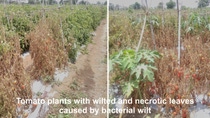
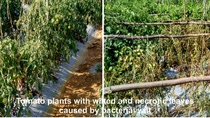
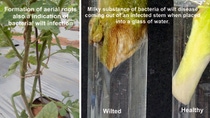
Bacterial Leaf Spot of Tomato
Disease and Pathogen
Bacterial wilt is one of the major diseases of tomato. The disease is known to occur in the hot -wet seasons in many parts of India. Even though there are now many varieties that have high level of survival, the wilt can still occur when environmental conditions are favorable.
Bacterial wilt of tomato in caused by a bacterium Ralstonia solanacearum. The pathogen has four different races and the bacterial wilt in tomato is mostly caused by the race 1 strain, which has a wide host range including tomato, potato, eggplant, geranium, and pepper.
Identification
At the early stages of disease, the first sign of wilt occurs on the youngest leaves, especially during the hottest part of the day. At this stage, part of the plants (one or two leaf lets or branches) wilt, and plants may appear to recover at night, when the temperatures are cooler.
Majority of the time the symptom appears on when plants in fruits bearing stage. Under favorable conditions (high temperatures and rainfall) the entire plant may wilt suddenly and die. In well-established infections, cross-sections of stems close to soil level (collar region) may reveal brown discoloration of infected tissue.
In unfavorable conditions the plants may be stunted, numerous adventitious roots on the stem above soil level, yellowing of lower leaves are evident.
A bacterial ooze test can be conducted at field level to identify the bacterial wilt infections. When the cut stem sections are placed in clear water for few minutes, a viscous white spontaneous slime streaming from the cut end of the stem will ooze out. This streaming represents the bacterial ooze exuding from the cut ends of colonized vascular bundles
Favorable Environmental Conditions for Disease
Symptom expression is favored by high temperatures (30-35ºC) with continuous wet in the root zone and symptoms of the disease may progress rapidly after infection.
Disease Transmission
The pathogen enters the roots through wounds made at planting by different means. The bacteria multiply in the vascular system, eventually clogging the water conducting vessels with bacterial cells and slime. In some cases, plant-to-plant spread can occur when bacteria move from roots of infected plants to roots of nearby healthy plants, often via irrigation practices. Apart from temperature and wetness, several other factors that may affect pathogen survival in soil and cultivation method, including soil type and structure, soil moisture content, organic matter in soil, water pH and salt content, and the presence of antagonist microorganisms. Further the bacteria can live on the roots of some plants and weed without infecting them but leads to spread the bacteria across the fields and areas.
Management:
Bacterial wilt is a very difficult disease to control, at the bacteria can remain alive in the soil without a host plant for many months and several years in host debris. The main control strategy has been the use of resistant varieties. However, the stability of BW resistance in tomato is highly affected by the pathogen density, pathogen strains, temperature, soil moisture, and the presence of root-knot nematode.
Before planting: Avoid planting in fields with the history of bacterial wilt.
Use raised beds to improve soil drainage. Use varieties with high survival percentage. As bacterial wilt resistant root stocks are available in tomato, grafting can be used to manage the wilt.
During growth: Pull out plants with roots and surrounding soil and burn everything. But do not openly carry materials through your field, because this will spread the disease. Do not re-plant tomatoes into the same spot. Reduce irrigation frequency and the quantity of water applied.
CMV disease in Tomato
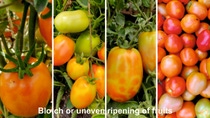
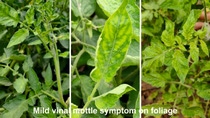
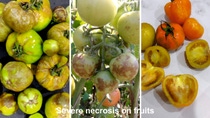
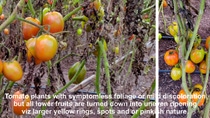

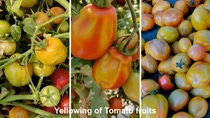
CMV disease in Tomato
Disease and Pathogen
Cucumber mosaic virus (CMV), in general, are not a routine problem in tomato in India until recent past. However, the virus was observed in tomatoes in Maharashtra (central India) from 2019 and spreading across other major tomato growing regions. Since then, CMV is, together with other potyvirus - Chilli vinal mottle virus (ChVMV) severely affects the tomatoes in summer. By symptom appearance on fruits, the disease is called by different name viz ‘Plastic- hard and plastic nature on the pericarp of fruits; Tiranga- red, yellow and green stripes on fruits, blotchy- uneven ripening.
Identification
The symptomology of the recent CMV outbreaks is quite distinct to characteristic symptom of CMV in tomato is filiformity, or the development of thin, shoestring-like leaves. But in the new out breaks majority of the time the symptom appears on when plants in fruits bearing stage by the presence of more yellowing, blotchy fruits extended with internal necrosis.
Yellowing of fruits: The foliage looks normal without any virus symptom, but all the fruits tuned to severe yellowing and turned to thick pericarp without any seeds. These types of fruits are referred to ‘plastic’ nature fruits by farmers.
Blotchy or uneven ripening: Tomato plants with symptomless foliage or mild discoloration but all lower fruits are turned down into uneven ripening viz larger yellow rings, spots and or pinkish nature.
Mild mottle and mosaic symptom on foliage: Sometimes, the plant showed also mild mosaic and mottling symptom when mixed infections with other potyvirus viz Chilli vinal mottle virus (ChVMV).
Disease Transmission
The CMV has an extensive host range and is transmitted by aphids in a nonpersistent manner. The primary source of CMV infection is from infected weed or crop hosts bordering a field. CMV is vectored by at least 75 species of aphid in a non-persistent manner, meaning that the virus does not remain in the aphid for more than a few hours.
Management:
Cucumber mosaic virus (CMV) has one of the largest host ranges in plant viruses and this virus is spread (transmitted) by several species of Aphids in a nonpersistent manner. That means, there is a high change for presence of virus and vectors near around your fields. So, develop a strategy to delay early infection by cultural practices to delay the arrival of aphids into your crop.
- Time planting to avoid exposing young plants to high aphid populations (e.g. during aphid migrations)
- Avoid planting with over lapping old solanum and cucurbit crops.
- Cover your fields with green shade nets and border crops (eg. Corn) to delay the arrival of aphids into field and to act as depositories for virus
- Remove any weeds that show the mosaic pattern growing near your fields
- Remove diseased plants from the field as soon as virus symptoms are noticed. This will reduce the spread of the virus by aphids.
- Use reflective mulches to deter aphids
- Mineral oil or rapid-acting insecticide sprays can be effective.
Tomato Leaf Miner
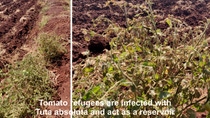
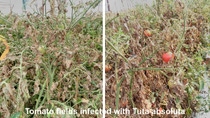
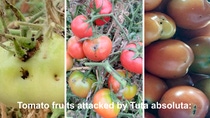
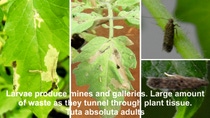
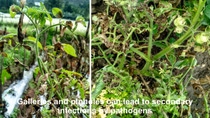
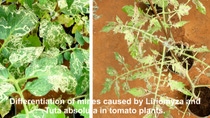
Tomato leaf miner (Tuta absoluta)
Disease and Pathogen
Tuta absoluta leaf miner is one of the major pests of tomato in India. It was first reported around 2014 end in India and now it is prevalence in all major tomato growing geographics in India. Tuta absoluta is sometimes referred to as the ‘tomato leaf miner, but the common name “tomato leaf miner” properly refers to other flies Liriomyza species. Liriomyza also havoc tomato plants if the conditions are favour. So, Differentiation of Tuto and Liriomyza is very important for chemical treatment, as these are controlled by different chemicals.
Identification
A Tuta absoluta lives on and in the leaves, stems, flowers and also in the fruit of tomatoes. Common signs and symptoms of Tuta absoluta on tomato plants are thin silvery irregular mines on the leaf surface (abnormal shaped white transparent blotches). Subsequently, damaged leaves shrivel, burned or in wet conditions rotten due to secondary infections. Green larvae with black heads, and their green to black frass (Tuto waste after they digest plant parts) can be found inside the tunnels. Fruits can be attacked by the miner as soon as they are formed. Fruits show puncture marks on the surface where the larva has entered the plant. Attacked fruits leads to rotten due to secondary infection. Damage can be particularly severe if the infestation happen in nursery stage.
Alike diseases: The mines created by Lyriomyza flies are quite distinct than Tuta absoluta mins. Lyriomyza mines are usually white with dampened black and dried brown areas. They are typically serpentine, tightly coiled, or of irregular shape, increasing in width as larvae mature.
Favorable Environmental Conditions for Disease
Tuta are nocturnal, being most active at dusk and dawn, and rest on leaves and other plant parts during the day. The leaf miner has four stages in its life cycle (Eggs, Larva, Pupa and Adult) and it is varies between 30-40 days depending upon the temperature conditions in the tomato field. At 27°C, eggs hatched in 4 to 6 days, larvae were ready to pupate in 11 to 13 days, and pupae emerged as adults in 5 to 8 days. Young larvae usually attack the leaves but can be found in growing points and in the flower. Later stage larvae tend to attack the fruit. Pupation happens in the mine, outside the mine, or in the soil.
Symptom expression is favored by high temperatures (30-35ºC) with continuous wet in the root zone and symptoms of the disease may progress rapidly after infection. The tomato leaf miner may be confused with the Potato tuber moth.
Disease Transmission
Short distance spread occurs because of flying and/or being carried by air currents from one plant/farm to the next. Infested transplants also form another pathway for entry and spread of the pest.
Management:
Early identification on presence of the pest in the fields helps with proper timing on chemical controls if needed. To monitor population levels, synthetic pheromones in sticky traps can be used.
- Do not plant new crops next to the old tomato crops, if it is infected with Tuta.
- Remove and destroy wild host plants such as night shades and refugee tomato plants (germinated from previous crops) around the farm.
- Plant clean seedlings free from all stages of the moth.
- Plant clean seedlings free from all stages of the moth.
- Early scouting and/or monitoring is important in establishing early enough the presence of the pest, threshold levels and for decision making.
- Pheromones traps can be used for mass trapping or mating disruption which helps in reduction of pest population.
